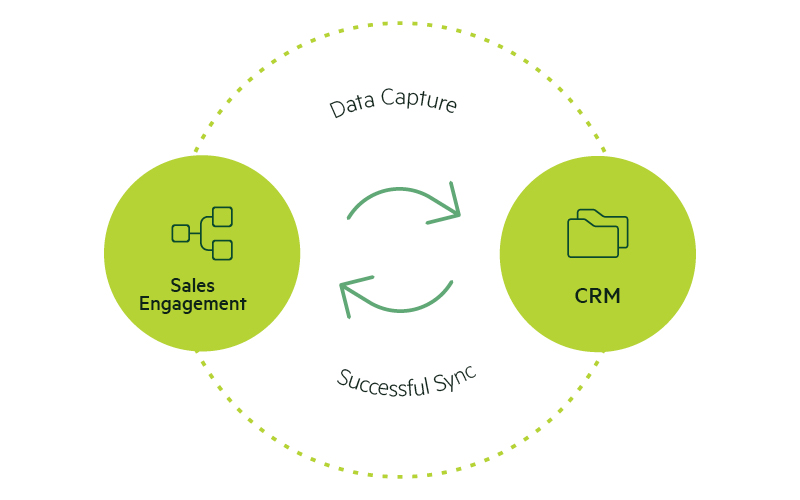You’re most likely looking for a way to empower your team to generate more pipeline, accelerate your deal cycle, and win bigger deals. But how do you choose a sales engagement platform that your team will love that also produces the best ROI?
We’re here to help you select sales engagement technology you can trust. Also, keep reading for a ready-to-use checklist to keep handy during the buying process that ensures your choice will directly tie back to business value.
Start With the Problems You Are Trying To Solve
What challenges are you and your team facing that motivated you to look for a sales engagement solution?
Maybe you’re seeing how much harder it is to break through the noise and connect with buyers. With the number of buying interactions needed to close a deal jumping from 17 to 27 after the pandemic (Forrester), more revenue teams are using multi-channel communication platforms.
Maybe your sellers need to adopt account-based selling tactics to better manage the increase in buyer stakeholders.
Or maybe changes in the buying process have highlighted the need for better workflows and analytics to help sales teams win more deals.
To guide your sales engagement evaluation process, start with questions like: What are the most inefficient processes in our business? What can be improved? What operational processes and workflows are lacking?
The gaps in your process will serve as the guiding criteria for finding the right sales engagement platform for your organization.
Top Considerations for Choosing the Best Sales Engagement Platform
Once you know the sales problems you are trying to solve within your organization, you should be able to start narrowing down your sales engagement software options. Start with these top considerations or just skip right to the checklist! Download a free checklist now.
1. Will the sales engagement platform help you increase revenue?
At the end of the day, the bells and whistles are only as good as the deals they help close.
Quick Tip: Time savings and tech stack simplification are very valuable outcomes, but increasing sales is the bottom line.
Here are some of the ways a good sales engagement platform can help you increase sales:
- Get results from new sellers more quickly with connected workflows, proven templates, and training with recorded calls
- Use insights from each interaction in the buyer’s journey to replicate success and win faster
- Close more deals when strategy, execution, automation, opportunity management, and coaching are together in one platform
- Accelerate the sales cycle when forecasting tools are within the selling workspace so gaps and opportunities can be identified earlier
- Improve rep performance with with call tracking, transcription, and analysis
- Focus sellers on the most engaged buyers and deals most likely to close
2. Does the sales engagement platform integrate with the rest of your tech stack?
The best sales engagement providers will offer all the tools and integrations your team needs to exceed their quotas and say goodbye to messy lead handoffs, inconsistent forecasts, and time-consuming data exports and imports.
Quick Tip: Make a list of your favorite sales tools – and those that you might use in the future – and make sure the sales engagement platform you’re evaluating integrates with them.
These are the most common sales tools that should integrate with a sales engagement platform:
CRM | This integration is crucial because it automatically records sales activities and updates both platforms in real-time – no manual work needed. Review the list of CRM integrations to make sure you have options in case you want to change CRMs in the future. You’ll also want to ensure the sales engagement platform you choose is committed to safeguarding your data and preventing data degradation.
Collaboration | Video conferencing and virtual communication is here to stay, so make sure your sales engagement platform integrates with the most common tools like WebEx, GoToMeeting, JoinMe, and Slack. That way it is seamless for even the largest enterprise organizations to stay on the same page.
Sales Data and Intelligence | Integrating sales intelligence tools puts all relevant data in one place, right where sellers are reaching out to prospects. Look for integrations like zoominfo, 6sense Sales Intelligence, and LinkedIn Sales Navigator to simplify research and build a solid pipeline.
Personalization | Multi-channel messaging is a cornerstone of sales engagement software, so make sure the platform you choose offers plenty of personalization-related integrations (think video, gifting, and logic-based apps).
3. Will the sales engagement platform meet the needs of your whole team?
The best sales engagement platforms are used – and loved – by everyone on the revenue team. Consider not just their needs, but also what is important to other stakeholders throughout the organization.
| Executives
These individuals will probably never login to the platform, but they will rely on the data and intelligence that it provides. Make sure the sales engagement platform surfaces trends, provides real-time insights, and includes forecasting capabilities. |
IT/Security Team
This team will assess the risks of the platforms you are evaluating and will likely be looking for very specific criteria related to data access, ISO 27001 certification, SOC2 compliance, configuration of the VoIP network, SSO capabilities, and more. |
Marketing Team
This team will be interested in the ease of the multi-channel messaging technology and the metrics available. They will likely be deeply involved with message creation and the transition of inbound leads. |
| Sales Enablement
This team is focused on high adoption of a sales engagement platform and helping sellers use it successfully. They will also be interested in features relating to the capture of data and new ways to help salespeople sell more effectively. |
Sales Leaders
Being able to extract conversation insights and make comparisons is a game-changer in coaching sellers. Leaders will also be very interested in forecasting within the sales workflow, customizable dashboards, and activity tracking. |
Sellers
This group wants one place to engage with buyers, automate manual tasks, and get the coaching and insights they need to win more deals. They need a platform they love and that will make selling easy. |
4. Does the sales engagement platform include all of your must-have features?
The features that are most important in a sales engagement platform will depend on your sales process, the issues you want to address, and the trajectory of your revenue organization.
Quick Tip: Don’t settle for a point solution that only solves one problem and adds another complication to your team’s tech stack. Choose a comprehensive platform that can grow with you.
To help get you started, here are some of the most sought-after features that revenue teams are using in modern selling:
Multiple Channels to Communicate with Buyers
Reach buyers using their preferred communication channel when your sales engagement platform includes a dialer, email, video, and LinkedIn integration to support social selling.
Call Recording and Conversation Intelligence
When calls are recorded and transcriptions are immediately available, sales teams can review the information at any time and share entire calls or snippets with internal teams and/or clients.
Analytics and Reporting
Selling is more data-driven than ever and some of the most popular analytics include engagement scoring, sentiment analysis, trend identification, messaging performance, and identification of deal gaps.
Forecasting
When forecasting is part of your sales engagement platform, you can drill into the deal data directly from the forecast and take action. Plus, with more comprehensive data available and the addition of AI, you have a better chance of forecast accuracy.
Coaching Capabilities
Take coaching to the next level with the ability to annotate call recordings with advice and join live conversations to whisper guidance. Plus, identify the best calls and cadences and share across the team to level up.
On-The-Go Access
A mobile app for field-based sellers can shorten the time between a prospect engaging with the brand and the seller engaging them. Plus integration with messaging apps like Slack ensure sellers stay in touch.
Integration
It’s no longer whether integration is available, it’s how many integrations are available. Modern sales teams are looking for platforms with a robust list of interactions that is continuously growing – especially the list of CRM integrations.
The Bottom Line on Choosing the Right Sales Engagement Platform
The right sales engagement platform will make it easier for your sales teams to generate more revenue. Sellers will be prospecting more pipeline using the best performing templates and benefitting from the consistency that comes with a defined multi-channel messaging process. Sales leaders will be increasing win rates with conversation intelligence and new coaching opportunities. And the entire company will be gaining new insight with the expanded analytics and reporting capabilities.
Because you’ve used the gaps in your existing sales process to build criteria for your new sales engagement tool, you can be confident in your decision and move on to your next challenge – implementation and adoption.
Want more insights on how you can get value out of the right sales engagement platform? Check out Saleslove’22, our annual customer conference!



